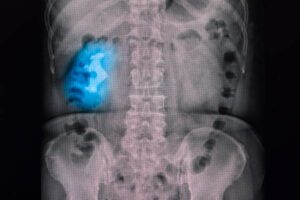Kidney stones are hard and small deposits of minerals and acid salts that form in the kidney. These tiny stones can be painful when passed through the urinary tract. Staghorn renal stones are larger compared to kidney stones and are composed of struvite (magnesium and ammonium phosphate) and fill the renal pelvis and at least one renal calyce.
In this article we would be discussing the causes of Staghorn kidney stone, its symptoms, prevention and treatments. Most of the cases of Staghorn kidney stone are unilateral (having just one kidney affected), while up to 15% of cases may have both of their kidneys affected.
Studies have shown that staghorn kidney stones occur in women more often than they occur in men. Why are women twice as frequently affected as men? Obesity, a high-salt diet, an increase in sugar in the diet, and diabetes are all risk factors for stone formation.All these risks have increased for women over the past 30 years. Men have these risk factors as well, but not as frequently as women have been diagnosed in the last 30 years, according to studies.
The Causes of Staghorn Kidney Stone

Staghorn kidney stones have risk factors that we should all look out for. As mentioned earlier, women are twice as frequently affected as men. Other factors include extremes of age, congenital urinary tract malformations, urinary stasis, urinary diversion, neurogenic bladder, indwelling Foley catheters, distal renal tubular acidosis, medullary sponge kidney, and diabetes mellitus (1-4).
- Atypical anatomy that lends itself to stone formation
Under certain conditions, substances normally dissolved in urine, such as calcium, oxalate, and phosphate, become too concentrated and can separate out as crystals. These crystals might sometimes form small stones or larger ones composed of struvite.
- Blockages in the urinary tract
When you’re not able to pass urine properly and you feel the pain or sensation when passing urine. In some cases of Staghorn kidney stone, immediate attention might be needed as one might not be able to pass urine.
- Long-term use of a urinary catheter
Urinary catheterization is a method of making way for people who can no longer pass urine as they should. In urinary catheterization, a latex, polyurethane, or silicone tube known as a urinary catheter is inserted into the bladder through the urethra. Hemodialysis allows urine to drain from the bladder for collection.
- Having had an earlier urinary diversion procedure
- Having a neurogenic bladder
- Long-term untreated kidney stones
When kidney stones have been left unattended, they might clump and develop larger crystals. These advanced crystals will do more damage than the initial kidney stone.
Symptoms of Staghorn Kidney Stone
These symptoms of Staghorn kidney stones are basically similar to those of kidney stones, but as explained earlier, the Staghorn kidney stones are larger and might have a different outcome.
- Painful urination
- Severe pain on one side of your abdomen and in your back
- Blood in your urine
- Foul-smelling urine
- Urine that appears cloudy
- A fever and chills
- Frequent low-quantity urination
You know you have to consult your healthcare provider when you have,
- The pain is so severe that you can’t sit still or find a comfortable position
- Pain accompanied by nausea and vomiting
- Pain accompanied by fever and chills
- Blood in your urine
- Difficulty passing urine
Prevention of Staghorn Kidney Stone
- Stay hydrated. Drinking more water is the best way to prevent kidney stones.
- Eat more calcium-rich foods
- Eat less sodium
- Eat fewer oxalate-rich foods
- Eat less animal protein
- Avoid vitamin C supplements
- Explore herbal remedies
The basic things we should know are to limit our sodium and sugar intake, stay hydrated at all times, and take more calcium-rich foods and fruits.
Treatment of Staghorn Kidney Stone
Treatments might be in stages. The stones are first removed by the SWL (Shock Wave Lithotripsy, the most common treatment for kidney stones in the U.S. Shock waves from outside the body are targeted at a kidney stone, causing the stone to fragment. The stones are broken into tiny piece) method. The PCNL (Percutaneous nephrolithotomy) method removes certain stones in the kidney or upper ureter (the tube that drains urine from the kidney to the bladder) that are too large for other forms of stone treatment such as shock wave lithotripsy or ureteroscopy.) method. Then antibiotics are used to treat the infection. Thirdly, recurrence should be prevented.
Conculsion
Staghorn kidney stones are large stones composed of struvite that accumulate in the kidney. Its risk factors include drinking too little water; exercising (too much or too little); obesity; weight loss surgery; or eating food with too much salt or sugar. Treatments include Shock Wave Lithotripsy (SWL), which is the most common kidney stone treatment in the United States; and Percutaneous Nephrolithotomy (PCNL), a technique used to remove stones in the kidney.
[starbox]



